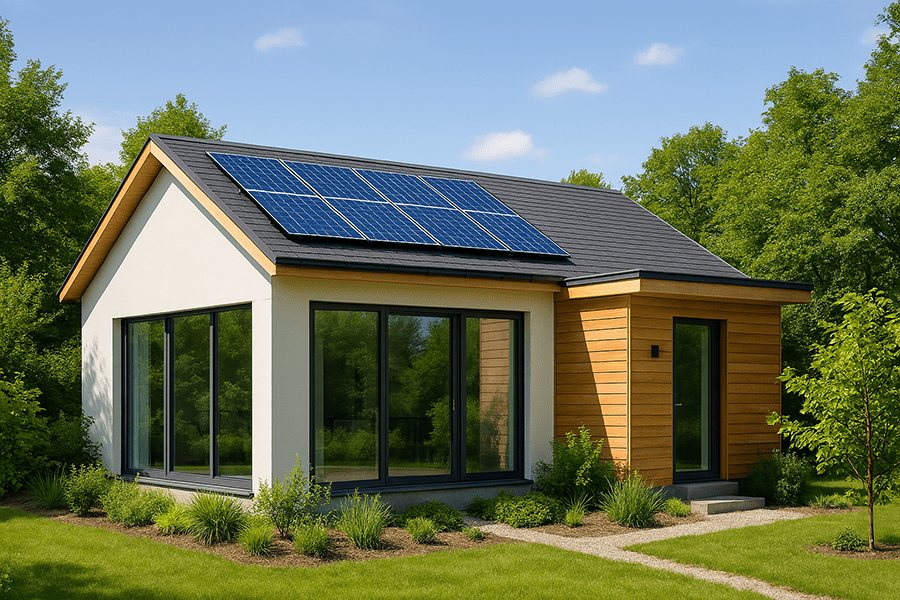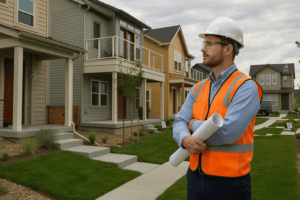Less Financial and Environmental Impact
Building a home is one of the most significant investments you’ll ever make. But in today’s world, it’s just as important to consider not only the financial cost but also the environmental impact of construction. By choosing sustainable materials, energy-efficient designs, you can create a home that is both cost effective and eco-friendly. In this guide, we’ll explore practical ways to build with less financial strain while reducing your ecological footprint.
Cost effective and eco-friendly strategies
- Be meticulous: I’m often asked to share my top three, five, or ten tips for making homebuilding more affordable. Unfortunately, cost reduction involves a thousand things, and nobody wants a list that long. A house construction budget can include 1,000 to 2,000 line items when accounting for all materials and labor down to the individual components. Savings come from accumulating small reductions, one line item at a time. The further down you drill, the more control you’ll have over costs—and the more work you’ll need to evaluate, compare, and shop for all the options. If you save ten dollars on one thousand line items, you save ten thousand dollars. It’s a meticulous and sometimes grueling process. Not everyone can do it.
- Choose your battles: The second question I get is about green building and achieving high performance without compromising affordability. Many elements of affordable buildings also reduce environmental impacts. For example, material-sparing techniques like Advanced Framing, which uses less lumber, and alternative foundations that reduce concrete consumption will lower your construction costs and carbon footprint. However, high-tech mechanical systems, hyper-insulated building shells, and high-performance windows add costs that aren’t compatible with affordable housing. Many builders attempt to construct a virtuous house that is affordable at workforce wages but fail. Instead of making it affordable, they revise the business plan to “achievable” housing. Achievable for whom? The upper middle class? You can’t aim for too many values in value engineering; achieving one is hard enough. If you’re a green builder, focus on high performance. If you build affordable housing, choose the greenest options that don’t blow up the budget.
- Think inside the box: When I published the first edition of my book, I had a construction company with a front office. People would drop in with plans their architect drew, assuring them, “This house will cost about $250,000 to build.” However, their bids came in at $450,000 to $650,000. They wanted to know what I could do to make their plans more affordable. “Very little,” I’d reply. Cost reduction starts with cost control in the design phase. A quick geometry study reveals that a box will enclose a given area with less exterior wall surface than any other shape except a circle. Since circular houses are difficult to build and sell, I go with a simple square whenever possible. The next best shape is a rectangle with a width that conventional dimensional lumber can span without requiring engineered joists and trusses. Lowering the exterior wall surface-to-floor area ratio also reduces weather exposure, creating a more energy-efficient shell before you even think about insulation.
- Going up beats spreading out: Most builders know that a two- or three-story home costs less to construct per square foot than a ranch. Why? A house’s two most expensive structures are the foundation and the roof. So, when you build a 2,500 sq. ft. ranch, you must construct the same size foundation and roof. If you divide this area into two floors, you reduce the foundation and roof by half. Adding a floor reduces the savings somewhat, but 1,250 sq. ft. of framed floor can cost up to $7,500, while the same area of slab-on-grade foundation runs about $18,750, and the roof costs $22,500. Do the math, and you’ll see that the savings on this hypothetical cost effective and eco-friendly house are a whopping $33,750 by going up rather than spreading out. You also reduce the disturbance to the earth by cutting the excavation required for the foundation and reducing the most carbon-intensive building material by half: concrete. Whenever you can replace concrete construction with wood, you do the earth a favor.
- Keep your services close to the heart: After I design the envelope of my house, I locate the utility core before laying out rooms. The utility core is where the most expensive trades concentrate, including mechanical, electrical, and plumbing—the MEPs. By placing the mechanical equipment in a central location, I reduce the length of ducts and improve the system’s performance. I then shorten the costly, high-amp wire runs by locating the electrical panel near the mechanical equipment.
- Kitchens and baths work better together: You hear about back-to-back bathroom plumbing, which saves a little money but not a lot. The primary savings come from grouping all the rooms using hot water—the kitchen, baths, and laundry—into the tightest area possible. Gary Klein, a hot-water efficiency expert, has a system worth studying. His approach emphasizes locating water fixtures (such as kitchens, bathrooms, and laundry) close together in a compact area to minimize hot water distribution losses. Although he focuses on reducing standby time waiting at the faucet, this approach also saves a lot of money on plumbing. I analyze my plans based on his 1:2 ratio, meaning that the longest dimension of the area containing the water fixtures should be no more than twice the length of the shortest dimension. This compact layout minimizes the distance hot water needs to travel, thereby reducing water waste, energy loss, and the time it takes to reach the fixtures—while also cutting plumbing costs by at least 20 percent.
- Splurge on sealing and insulation: Insulation is cheap. By sealing all the little air leaks in your building shell and increasing the insulation in your walls and ceiling, you can significantly reduce the size of your air conditioning equipment. When you do the math, a few hundred dollars of added caulk and fiberglass can save a thousand or more in air conditioning and heating. Although costly insulation systems like foam exist, you can achieve comparable results with careful craftsmanship. A sharp eye and a well-aimed caulking gun can tighten a house as effectively as blow-in foam—and sometimes better.
- Navigating commodity swings: I usually build using the principles of 24-inch center framing while optimizing my structural components to size every span appropriately. If a window header requires a single 2×6, I won’t install a double 2×10—why waste the wood? Why waste the money? However, I don’t dogmatically apply any technique because construction materials are commodity goods that can fluctuate in price. When lumber is cheap, I follow Advanced Framing strictly, using the 24-inch module on all my walls, including the exterior (yes, you can), and sheathe the exterior in strong, economical OSB. However, sheathing prices spike occasionally—such as after a major hurricane—and I take a different approach. I omit the OSB entirely by returning to the old-fashioned studs at 16 inches on center with let-in bracing, using the gypsum board brace wall approach to achieve the required shear values. For example, I use ½-inch drywall to brace my walls rather than OSB. It’s detailed in IRC Table R602.10.3(3). This approach allows the interior gypsum wallboard to serve as a bracing material to resist lateral forces. It requires an unusual nailing pattern, 7 inches on center, and has certain limitations, such as being unsuitable for some thin portal walls, but it provides an alternative. Likewise, when lumber prices climb too high, I consider steel studs. I evaluate the options and never commit to a single solution.
- Read the good book: Our model building codes get more complicated with each cycle, and builders often complain. Instead of learning new options, we prefer to apply a few old rules of thumb daily without thinking. The model codes become more complex because building inspectors, engineers, consultants, and material manufacturers add options every three years. Within these options, you’ll find a goldmine of cost-reducing strategies. I’ve already mentioned the “GB” brace wall approach. How about using fiberglass insulation as a draft stop instead of cutting blocks to nail between the studs along a stairway wall? How about adding exterior insulating sheathing to reduce the stud size of an exterior wall? How about using the plain concrete foundation approach, slightly thickening a foundation wall, and omitting the steel reinforcement? Many options in the building code can help you reduce costs. If you spend a weekend afternoon lying in a hammock with iced tea and the IRC, you may find ways to save money when you’re back on the job site on Monday.
- Single-stone options: Look for products that perform double duty. For example, if your climate zone requires continuous exterior insulation (CE), consider insulated siding that provides both cladding and CE. Consider insulated sheathings like Ox Engineered Products’ ThermoPLY Structural Sheathing. This multi-functional sheathing combines structural sheathing, insulation, and a weather-resistant barrier. Some versions come with foldable corners, eliminating the need for taping in challenging areas and providing continuous water resistance and air sealing. This design simplifies installation and improves the overall efficiency of the building envelope.
implement these cost effective and eco-friendly strategies
Smart building choices can help you save money and protect the environment—without sacrificing quality or comfort. Whether you’re planning a new home or looking for ways to make your current one more sustainable, implementing these cost effective and eco-friendly strategies can make a significant difference. Ready to start building smarter? Contact our experts today for guidance on sustainable and budget-friendly construction solutions!



